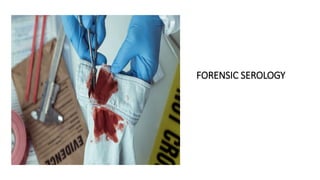
Species origin.pptx
- 2. Human Blood Animal Blood Blood Cells Red blood cells, white blood cells, and platelets are the cellular components of the human blood. Most animals comprise red blood cells, white blood cells, and platelets. Animals with a closed circulatory system comprise hemocytes. Blood Group Humans comprise ABO blood group and Rh blood group. Animals comprise different blood groups Respiratory Pigments Hemoglobin is the respiratory pigment of humans and other vertebrates Hemoglobin, haemerythrin, haemocyanin, and chlorocruorin are the four types of respiratory pigments in invertebrates. Blood Color Human blood is red in color. Red, blue, green, and pink are the colors of the blood in animals. Red Blood Cell Antigens A, B, and Rhesus antigen are the three types of antigens present in the red blood cells of humans. Red blood cells of animals may contain different types of antigens. Red Blood Cell Nucleus and Organelles Humans and other mammals do not have a nucleus and organelles in red blood cells. Animals other than mammals have a nucleus and organelles in red blood cells. White Blood Cells Humans have five types of white blood cells. Different animals have different types of white blood cells.
- 3. SPECIES OF ORIGIN Most assays for species identification immunochromatographic assays precipitation-based assays include ring assays, Ouchterlony assays, and crossed-over immunoelectrophoresis.
- 4. Immunochromatographic assays OBTI and the ABAcard HemaTrace® Human Hemoglobin Protein RSID™- Blood Identification of Human Glycophorin A Protein
- 5. precipitation- based assays include ring assays RING ASSAY PROCEDURE: Sample preparation and extraction Controls (positive and negative) Loading of antibody and samples Immunodiffusion reaction
- 6. OUCHTERLONY ASSAY • Cross over gel diffusion is a technique where antigens and antibodies are left to react overnight on a gel plate. • Agglutination / precipitation is recorded by bands that are formed between wells. OUCHTERLONY ASSAY PROCEDURE: Sample preparation Controls • Positive (known serum) • Negative (extraction blank) • Substrate controls (extraction of substrate from unstained area) Agarose gel preparation Loading antibodies and samples Immunodiffusion reaction
- 8. Immuno electrophoresis • But cross-over gel diffusion takes a lot of time and the little sample that we have will get evaporate by then. • Electrophoresis helps to speed up the process/diffusion. • We perform horizontal electrophoresis using an agarose gel. • Antigens and Antibodies are plotted at 2 different ends of the agarose plate. • Multiple samples can be tested at the same time.
- 9. Immuno-electrophoresis • The sample load (Ammonia extract) must face the cathode (black end) and the antisera must face the anode (red end). • Use filter paper/tissue paper wicks moistened in tank buffer to connect the gel plate with the tank buffer. • The usual electrophoresis run is set at 150V, 15mA for 20 minutes.
Editor's Notes
- An antihuman antibody that is used in the identification of human samples can be made by introducing human serum into a host animal, which then produces specific antibodies against the human serum proteins. Antibodies produced from different species of host animals may Forensic Biology, Second Edition 246 produce variations in the characteristics of reactions. Since albumin is the most abundant protein in human serum, the antihuman antibody that is produced reacts strongly with human albumin. Albumin is a protein that plays important roles in the maintenance of the vascular circulating fluid and the transportation of various substances such as nutrients, hormones, and metabolic products. Blood is drawn from the host animal and the serum portion is collected. The collected serum is a polyclonal antihuman antiserum containing a mixture of antibodies against various human serum proteins. Likewise, an antibody against animal serum proteins can also be made to identify animal species of interest. Other antibodies such as antihuman hemoglobin (Hb) antibodies can also be used to identify the human origin of a sample. Hb is an oxygen-transport protein that is found in erythrocytes (Chapter 12). Purified Hb can be used to generate monoclonal and polyclonal antihuman Hb antibodies. Likewise, antibodies recognizing glycophorin A (GPA), a human erythrocyte membrane antigen (see Section 13.2.1.2), can also be produced in a similar manner. RING ASSAY PROCEDURE Sample preparation and extraction • Extract a portion of a stain with saline at 4°C overnight. Controls • Include a positive control (known human serum sample) and a negative control (extraction blank). Loading of antibody and samples • Spin the antihuman antibody in a microfuge and transfer the supernatant into test tubes or capillary tubes (depending on the volume of the stain and the antiserum extracted). • Place the sample carefully over the top of the antiserum solution, which is usually denser than the sample. Immunodiffusion reaction • Carry out the reaction at room temperature. • In a positive reaction, white precipitate between the two layers can be observed after several minutes. This indicates that the sample is of human origin. No precipitate is formed if a bloodstain extract is from a nonhuman origin